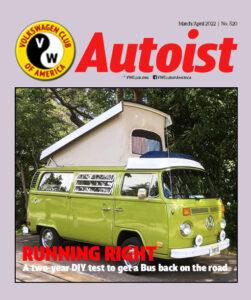 DIY CHALLENGE
DIY CHALLENGE
Rebuild gives way to rebuilds in long haul to get a 1978 back to trouble-free busing
A VW Bus DIY engine-rebuild project can painfully expose gaps in the knowledge, thoroughness and mechanical abilities of its owner/mechanic — never so much as with my Sage Green 1978. ¶ The May/June 2020 Autoist cover story told of the failure of its engine and my plans to rebuild it myself. It’s been over two years since I embarked on the journey, and it’s still not at an end.
The engine is a 2.0L Type 4 powerplant with hydraulic lifters and Bosch L-Jet fuel injection, and the first rebuild was completed in May 2020.
But that was only the end of the beginning of my challenge. Four more engine-pulls were required over the next 13 months to address noise, a broken piston ring, a seized main bearing and a serious oil leak. An engine fire was also thrown in just to keep it interesting.
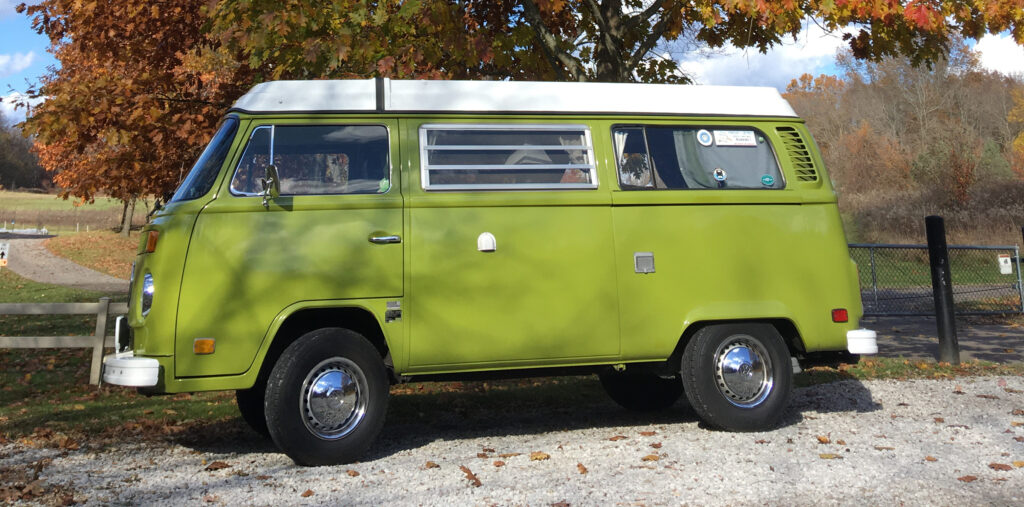 Here’s what happened:
Here’s what happened:
In October 2019, I learned my engine would have to come apart because one of the hydraulic lifters was being eaten by its cam lobe. The valve and lifter kept losing their adjustment, and when I tried to remove the lifter, I found that it had mushroomed and would not come out of its bore. The lifter finally wore down so far that a hole developed on the lifter face into the oil reservoir. It didn’t lift anymore after that. Upon engine disassembly, cracks in the cylinder heads and a fractured No. 1 main bearing were also found. Wow, time for a fresh start. Click here to listen to the engine noise.
My goal was to build a bone-stock replacement engine that would be as smooth, quiet, and powerful as the factory original.
One of the best things I did was to contact the founder of our local VW Bus group LEAKOIL. He was able to supply an engine case suitable for rebuilding and provided the connection to George at European Motorworks in Hawthorne, California, for the machining services and many of the parts.
The first misadventure was shipment of the engine case from Ohio to California. Although it was very carefully packed, the oil breather section of the case was broken off when it arrived. Luckily, the shipment insurance paid for another align-bored engine case that George had available. (European Motorworks is one of the few shops that can align-bore a Type 4 engine case.)
By the end of January 2020, I had everything except the cylinder heads available to start assembling the engine, using the Tom Wilson book “How to Rebuild Your Volkswagen Air-Cooled Engine” for guidance. I took my time and was very careful to make sure everything was done correctly during the build (or so I thought!). After much debate about the heads, the decision was made to bite the bullet and go with the “Blueprint Special” stock heads from Len Hoffman in Georgia.
Finally, on May 18, 2020, the rebuilt engine came to life! It was indeed smooth, quiet, and powerful … for the first 200 miles.
Then, a strange intermittent knocking noise started. Thanks to thesamba.com, excessive camshaft endplay was quickly identified as the probable cause. I pulled the engine, removed the oil pump and found the endplay at 0.010-inch versus the wear limit of 0.006-inch. Unfortunately, the Wilson book makes no mention of checking camshaft endplay. I then remembered that the camshaft was a snug fit into the thrust bearing during assembly. That snug fit should have been a warning, but I was too much of a “newbie” to know it. Without the proper endplay (and therefore lubrication), the camshaft quickly “ate” the thrust bearing. (There’s more to this story that we’ll get to later.) I bought new cam bearings, split the case open, and reassembled everything — this time making sure that the thrust bearing endplay was correct.
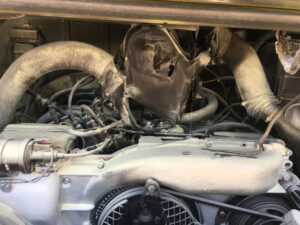 On July 3, 2020, the Bus was back on the road again … for two days.
On July 3, 2020, the Bus was back on the road again … for two days.
On July 4, 2020, I started the Bus, backed out of my driveway and headed down the street. After no more than a few hundred feet, the engine died and would not restart. Glancing in the side mirrors, I saw smoke billowing from the engine air intakes. I rushed out and opened the engine compartment. FIRE!!! I ran to the passenger side, opened the sliding door, grabbed the fire extinguisher in front of the rear seat, and was luckily able to put the fire out in short order.
Of course, I was happy to have had a fire extinguisher available that did its job, but it was unfortunately a dry-chemical unit. That dry chemical is a nightmare. It sticks to everything and immediately begins corroding any bare metal it contacts. I didn’t pull the engine to clean everything up, but I should have. In the end, all the engine tin and almost everything else that bolts to the engine had to come off to clean out the chemical. The replacement fire extinguisher is a Halotron unit that leaves no residue. Never again!
The fire was caused because I missed tightening the fuel line hose clamp on the left side of the cold start valve for the fuel injection. This is located right next to the distributor. Apparently, fuel leaked (or sprayed) out and was ignited by the normal arcing inside the distributor cap. The fact that I was using 5/16-inch ID fuel injection hoses instead of the correct 7mm ID lines was also to blame. Lesson learned!
The items destroyed by the fire included the fuel injection wiring harness, heater booster fan, distributor cap, rotor, spark plug wires, rubber fuel lines, fan guard, oil pressure sender, various vacuum hoses, and the insulating panels on the “ceiling” of the engine compartment. I made an insurance claim and Chubb Insurance was great to work with. It paid for a brand-new Kyle FI wiring harness, all the other parts and included a payment for labor hours even though I would be doing the repairs myself. That funded the purchase of four new Hankook Vantra tires!
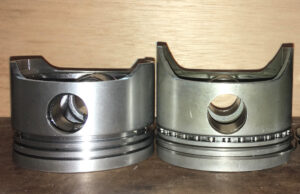
On July 26, 2020, the Bus was back on the road … for the third time.
The next few hundred miles were mostly uneventful. However, the cold engine sounded somewhat like a diesel when accelerating. Once it warmed up, the noise went away. It seemed that the brand new Mahle pistons were slapping in their brand new Mahle cylinders. Sigh. I wondered whether something should be done about that until the oil was changed on September 26, 2020. That’s when a piece of a piston ring was found in the sump plate. OK, I guess this engine is getting pulled out again!
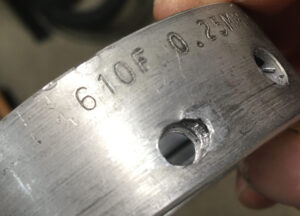
At least this time the case did not need to be split open, only the heads, pistons and cylinders removed. The piece of piston ring belonged to the wavy center spacer between the two oil control rings on one of the pistons. Another newbie mistake. Apparently, I broke this piece off when installing the piston in its cylinder, and it took this long to escape and find its way to the oil sump.
I also wanted to address the piston slap issue. The brand new Mahle pistons had significantly shorter skirts than the old Mahle pistons they replaced, which was probably why they were rocking and slapping in their cylinders. So, I had the new Mahle cylinders honed, installed new Hastings rings on the old Mahle pistons and put the engine back together again.
On October 24, 2020, the Bus was back on the road again. The engine had logged around 900 miles since its original installation back in May.
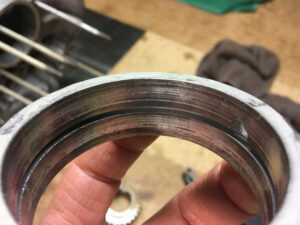
And 235 miles later, on November 14, 2020, disaster struck. The engine seized after driving less than a mile. While trying to start the seized engine, the solenoid jammed and would not disengage the starter from the flywheel. This ruined the battery and starter.
Yet another newbie mistake. It took several phone calls and email photo exchanges with George at European Motorworks to finally convince me, but yes, when I put the case halves back together after repairing the camshaft bearing issue, the No. 3 main bearing was not properly seated on its dowel pin. I has pinched the bearing. How it survived for 900 miles is a mystery, but it did.
So, out the engine came again, and of course this time it had to be completely disassembled. I measured the bearing seats in the case and found that the No. 3 bearing seat was distorted, no doubt due to the pinched bearing. George indicated that the case should be align-bored again, and because he did not want me to have a case with bearing seats two sizes larger, he provided another case that had only been aligned-bored once.
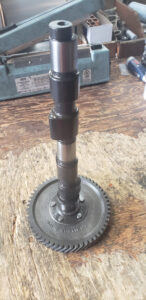
In the end, George cleaned up the No. 3 crankshaft journal and shipped me a replacement case. My only cost was the shipping to send the damaged case and crank to him.
Because there had been camshaft endplay issues before, it was checked while disassembling the engine, and sure enough, it was starting to open up again. I wasn’t sure why this was happening, but it persuaded me to use a double-thrust camshaft bearing setup when the engine went back together.
In January 2021, the work to reassemble the engine began. But I just couldn’t get the double-thrust cam bearing setup to work. The camshaft would always bind up at some point it its rotation. Further investigation finally determined that there was 0.003-inch of axial runout on the thrust faces of the aftermarket camshaft. This is nearly all the allowable endplay for the camshaft. This runout, combined with other imperfections in the case and bearings, was causing the binding. I also suspected that this runout was acting like a hammer or cutter when the camshaft was spinning in the running engine, causing the thrust bearing to wear prematurely and opening up the endplay. Click here to see the shaft face runout measurement.
For comparison, the thrust face runout on the old OE VW camshaft (with ruined lobes) was checked. It had none. I spoke to George about this and he checked the runout on all of the aftermarket cam blanks he had available at his shop. All showed similar levels of runout.
I took the aftermarket cam to a local machine shop and asked the reps to clean up the thrust faces. They were warned that only a small amount of stock could be removed, or the resulting endplay would be too large. They missed that last part apparently, because the cam had 0.010-inch of endplay after they were finished. WAAAY too much. It’s now sitting on a shelf, waiting for the day that someone decides to make oversize camshaft thrust bearings. I think it will turn to rust before that happens.
The only option left was to go with a reground OE VW camshaft, which George was able to supply, but it didn’t arrive until early May 2021. A new cam also meant new lifters, so those were ordered as well.
The reground camshaft had virtually no thrust runout, as expected, and rotated freely with the double-thrust bearing setup. The engine was reassembled with all new bearings and lifters, and on June 16, 2021, it was installed in the Bus, along with a new starter and starter bushing, and a new battery.
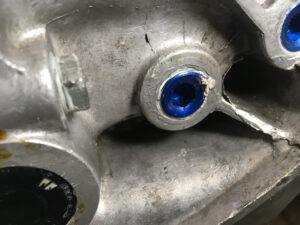
Unfortunately, after the camshaft break-in run of the engine, I found a large puddle of oil on the garage floor, dripping out between the engine and transmission. Out came the engine again. One of the large threaded oil gallery plugs was not sealing properly and appeared to be backing itself out. It was resealed and threaded in much more tightly in the hope that this would stem the tide.
Back into the Bus the engine went, and there it has stayed since then, logging nearly 3,000 miles as of early December, the start of winter hibernation. Before that point the engine was actually running very well, but not without issues.
Although I used a new gasket and sealant during assembly, the oil pump at the engine case mating point has a minor leak (not the oil pump cover, surprisingly). A minor leak also persists at the flywheel end. This leak seems to be fouling the clutch as it’s now chattering slightly when starting from rest. Whether the leak is still from that gallery plug or some other source is unknown.
Most concerning is the clacking noise that I’ve been unable to identify. It’s been there from the start of this engine build. It sounds valve-train related, but also heavier than that. It’s there regardless of engine temperature. Pulling individual spark plug wires makes no difference. Click here to listen to the clattery Bus engine.
I’m planning to pull the engine again before spring to address the oil leaks. I’m wondering if I need to go deeper to seek out the source of the noise. The oil was changed just before winter hibernation, and the sump plate and the oil itself were carefully examined for signs of metal debris, but nothing unusual was found.
The saga continues … ![]()
ALSO IN THIS ISSUE:
- CONVERTIBLES: VW no longer sells them here, but perhaps history will repeat.
- FORGOTTEN CARS: Hot Rod magazine lists some of its favorites, including the VW Squareback.
- A REMEMBERANCE: Elton Leppke’s gentle touch provided inspiration for an auto hobby and more.
- TOY TIME: When the weather is less favorable for driving, turning to toy collecting can be a fun hobby.
PLUS OUR REGULAR COLUMNS AND FEATURES:
- Small Talk – VW + Audi at a glance
- Retro Autoist – From the VWCA archives
- The Frontdriver – Richard Van Treuren
- Classified – . . . ads from members and others
- Parting Shot – Photo feature
- VW Toon-ups – Cartoon feature by Tom Janiszewski
LOGGED-IN MEMBERS CAN SEE THE ENTIRE AUTOIST ISSUE BY CLICKING ON THE “AUTOIST ARCHIVE” OPTION UNDER THE “AUTOIST” TAB.
